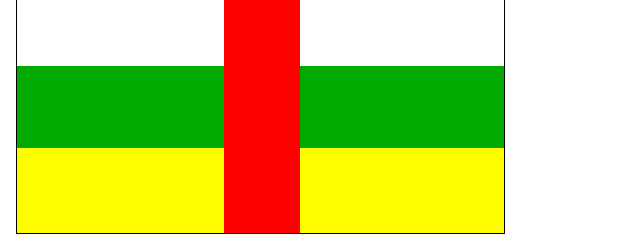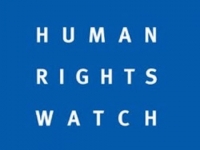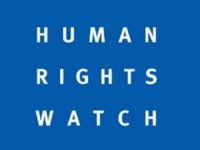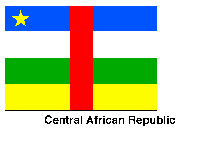Local
Armed Groups Target Civilians in Central African Republic
Violence Spikes in Central Region

Central Flag Africa (Source: wikipedia)
USPA NEWS -
Armed groups fighting for control of a central province in the Central African Republic have targeted civilians in apparent reprisal killings over the past three months, Human Rights Watch said today. The attacks have left at least 45 people dead and at least 11,000 displaced.
Armed groups fighting for control of a central province in the Central African Republic have targeted civilians in apparent reprisal killings over the past three months, Human Rights Watch said today. The attacks have left at least 45 people dead and at least 11,000 displaced.
Since late 2016, two factions of the predominantly Muslim Seleka armed group have clashed heavily in the volatile Ouaka province: the Union for Peace in the Central African Republic (l´Union pour la Paix en Centrafrique, UPC), consisting mostly of ethnic Peuhl, and the Popular Front for the Renaissance in the Central African Republic (Front Populaire pour la Renaissance de la Centrafrique, FPRC), which has aligned itself with the anti-balaka ““ the main armed group once fighting the Seleka.
“Armed groups are targeting civilians for revenge killings in the central part of the country,“ said Lewis Mudge, Africa researcher at Human Rights Watch. “As factions vie for power in the Central African Republic, civilians on all sides are exposed to their deadly attacks.“
Human Rights Watch visited Ouaka province in early April 2017, and interviewed 20 people in Bambari who had recently fled the fighting. They gave names and details of about 45 civilians (17 men, 13 women, and 15 children) who had been killed by both sides. The total number is most likely higher because scores of people remain missing. The UN peacekeeping force in the country, the Multidimensional Integrated Stabilization Mission in the Central African Republic (MINUSCA), has deployed approximately 1,000 of its 12,870 members to Ouaka province over the past three months, but the attacks persist.
Escalating violence in the area underlines the importance of getting the newly established Special Criminal Court (SCC) up and running, Human Rights Watch said. The court ““ which was established by law in June 2015 ““ will have national and international judges and prosecutors, but will operate within the national justice system. It will investigate and prosecute grave human rights violations in the country since 2003. The latest round of killings began in mid-February when anti-balaka fighters ambushed a group of civilians on a truck in the village of Ndoussoumba, killing at least 16 Peuhl civilians. One survivor, “Asatu,“ 20, told Human Rights Watch the she jumped out of the truck when the attack began and was shot in the leg. “I saw at least 20 anti-balaka attackers and many bodies on the ground,“ she said. “The anti-balaka were shooting at us from a close distance with Kalashnikovs and homemade rifles.“ Around March 19, anti-balaka fighters attacked three Peuhl men in Yassine, a town in a gold- producing area northeast of Bambari, which had been under UPC control since 2014. Two of the men died ““ three witnesses described both men as local butchers who had not participated in fighting. A third man said he narrowly escaped after a bullet grazed his shoulder. On March 20, anti-balaka and FPRC fighters in the towns of Wadja Wadja and Agoudou-Manga, suspecting an upcoming UPC attack, ordered town residents to move to Yassine for their safety. However, at about 5 a.m. the next day, UPC fighters attacked Yassine, killing at least 18 civilians, including at least 10 children.
THE PEUHL ( UPC FIGHTERS) STARTED TO SHOT AND THROW GRENADES AT US...
“The Peuhl [UPC fighters] started to shoot and throw grenades at us,“ said “Marie,“ an Agoudou-Manga resident who was forced to move to Yassine. “They shot at everyone. The anti-balaka just abandoned the civilians. I saw dead children as I ran away.“ A man from Wadja Wadja, “Clement,“ who was in another part of the village when the attack began, said he lost his mother and four children in the attack. “My wife later told me the kids were playing on the mat [outside a hut] with the baby when the attack started. We found them there, dead on the mat. They had all been shot. I lost my 7-month-old son, my 3-year-old daughter, my 10-year-old son, and my 13-year-old daughter.“
HUMAN RIGHTS WATCH DOCUMENTED OTHER KILLINGS OF CIVILIANS BY THE UPC----------------------------Human Rights Watch documented other killings of civilians by the UPC in the area around the same time, such as in Ouropo, Kpele, and Moko. On April 13, Doctors Without Borders said it had documented additional killings of civilians around Bakouma and Nzako, in the Mboumou province, and in the town of Bria, in the Haute-Kotto province, both east of the Ouaka province. Human Rights Watch was unable to access those areas due to ongoing violence.-------------------------------------------
“These killings are caused by cycles of reprisals,“ one local official in Bambari, capital of Ouaka province, told Human Rights Watch. “A group will kill one person, so the other group will kill three, then the first group will kill twenty.“
Gen. Ali Darassa Mahamant commands UPC forces, which have controlled most of Ouaka province since 2013. In December 2016, the UPC executed at least 32 civilians and captured fighters after clashes with the FPRC in Bakala, west of Bambari. In February, MINUSCA asked Darassa to leave Bambari to avoid bloodshed. He and most of his forces are now based about 50 kilometers outside the town.
Hassan Bouba, the UPC´s political coordinator, denied that the UPC had attacked Yassine. “On the contrary, the village was attacked by the coalition of anti-balaka and FPRC, and the UPC had to come to its rescue,“ he said by telephone on April 19. “The village was attacked because the coalition resented that the people of Yassine lived with Peuhl. Our men are still there to protect its inhabitants.“
The FPRC´s political cabinet director, Lambert Lissane, said by telephone on April 24 that FPRC fighters and their anti-balaka allies were not involved in attacks on Peuhl civilians. People were spreading misinformation, he said.
At least 11,000 people displaced from the fighting have sought shelter in Bambari since March 19, aid officials there said, adding to the tens of thousands of displaced people already in the town. Access to food and shelter remain serious problems.
Governments have pledged only 7.9 percent of the US$399.5 million needed for the UN´s humanitarian response plan.
Crimes in Ouaka province fall under the jurisdiction of the SCC, and the International Criminal Court (ICC).
In September 2014, the ICC opened an investigation into crimes in the Central African Republic since 2012. The investigation offers the chance to bring an important measure of accountability for the crimes, but will probably try only a small number of cases. The government appointed the SCC chief prosecutor in February, but the court still lacks staff and facilities. The government, UN, and partner governments should provide financial, logistical, and political support for the court to begin its work promptly, Human Rights Watch said. “In the central region, the fighting has worsened and the civilian death toll has climbed,“ Mudge said. “Renewed attention and holding abusive commanders to account are needed to keep the country from sliding back into the large-scale blood-letting of its recent past. Source apo on behalf of Human Rights Watch (HRW).
Liability for this article lies with the author, who also holds the copyright. Editorial content from USPA may be quoted on other websites as long as the quote comprises no more than 5% of the entire text, is marked as such and the source is named (via hyperlink).








